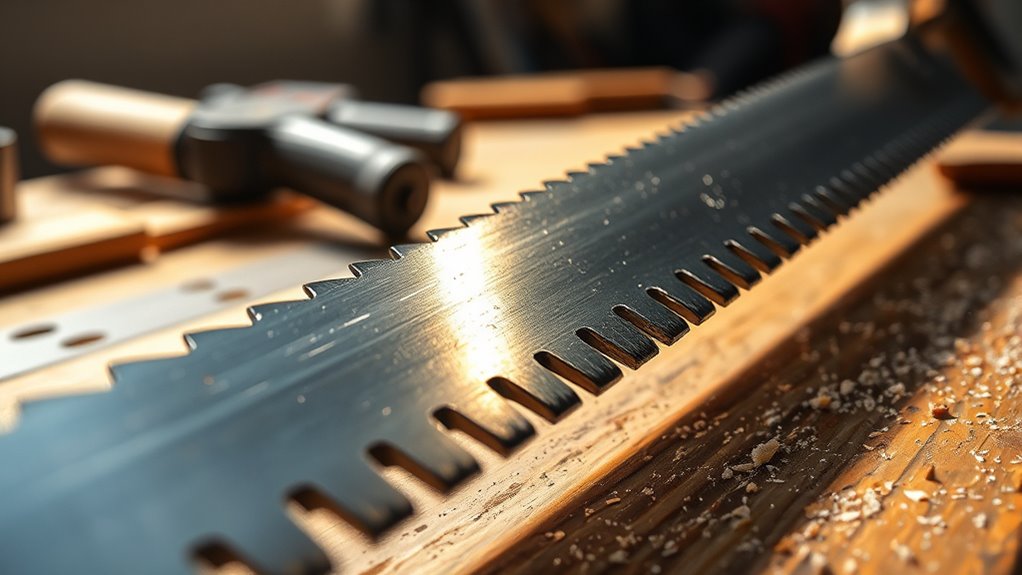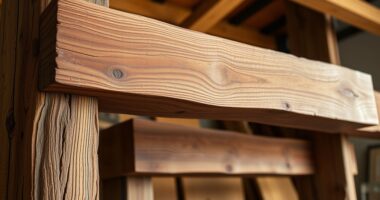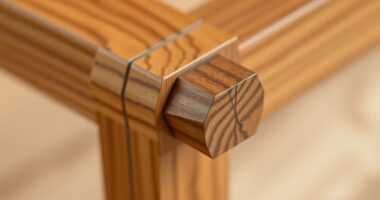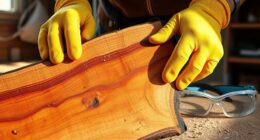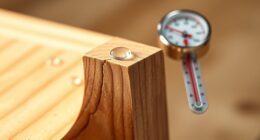If your crosscut saw wanders, the most common cause is an improperly aligned or dull blade. When the blade is misaligned or damaged, it pulls away from the cut line, causing uneven results. Regularly check and adjust the blade’s alignment, replace warped or dull blades, and keep everything well-maintained. Proper technique and handle stability also help. Keep going to discover simple adjustments that can put your cuts back on track.
Key Takeaways
- Misaligned or warped saw blades cause wandering, so check and properly align or replace them.
- Dull or damaged blades create rough cuts, leading to loss of control and wandering.
- Loose or wobbly handles reduce stability; tighten or replace them for better guidance.
- Insufficient saw maintenance, including loose bolts and lack of lubrication, can lead to deviations.
- Poor cutting technique, such as an unbalanced stance or excessive force, increases the risk of wandering.
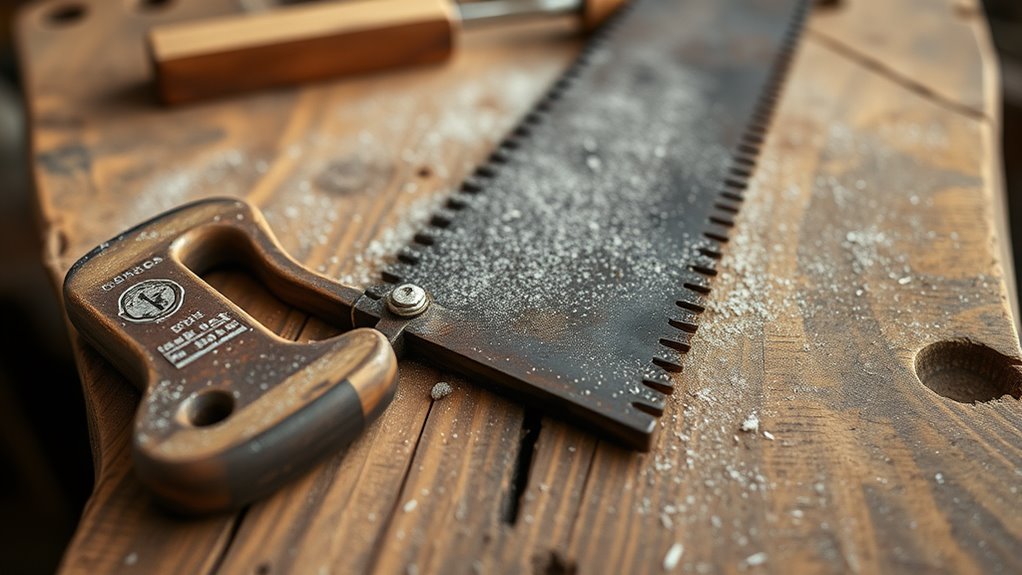
If your crosscut saw keeps wandering or veering off course, it can make your work frustrating and inefficient. The most common reason for this frustrating issue is improper saw blade alignment. When the saw blade isn’t perfectly aligned with the cut line, it naturally pulls to one side, causing your cuts to be uneven and making you exert extra effort to stay on track. To fix this, you need to check that the saw blade is straight and true. Remove the blade and inspect it for bends or warping. If it’s warped, replacing it is usually the best option. If the blade looks fine, you can fine-tune its alignment by adjusting the blade’s mounting bolts or using a saw alignment tool. Proper saw blade alignment ensures that the cut follows your intended line, reducing wandering and giving you cleaner, more precise results. Regularly checking the blade’s condition can prevent issues before they arise, maintaining optimal performance. Handle stability also plays a significant role in preventing wandering. When your handle is loose or wobbly, you lose control over the saw’s movement, making it harder to guide the blade straight through the wood. A stable handle gives you confidence and control, allowing you to follow your cut line smoothly. If you notice any looseness or play in the handle, tighten any screws or bolts securing it. If the handle itself is damaged or broken, replacing it can restore stability and improve your control over the saw. Remember, the more stable your handle, the less likely you are to unintentionally drift off course. Beyond blade alignment and handle stability, it’s essential to ensure your saw is properly maintained overall. Keep the blade clean and sharp—dull blades tend to wander because they don’t cut smoothly, forcing you to compensate with extra pressure that can throw the saw off track. Lubricate moving parts as needed and check for any loose bolts or screws regularly. Proper maintenance keeps the saw functioning as intended and minimizes wandering caused by mechanical issues. Finally, your stance and grip influence the saw’s tendency to wander. Stand firmly with a balanced stance and grip the saw firmly but not too tightly. A loose grip can cause the saw to sway, while excessive force can cause binding or deflection. Practice steady, controlled movements, and stay focused on following your cut line. By paying attention to these details, you’ll find that your crosscut saw becomes much more predictable, making your woodworking safer, faster, and more accurate.
Frequently Asked Questions
How Often Should I Replace the Blades on My Crosscut Saw?
You should replace your crosscut saw blades when their durability diminishes, and they no longer cut effectively. Typically, this means sharpening them regularly—about every few uses—depending on your workload. If sharpening doesn’t restore performance or the blade shows signs of damage or excessive wear, it’s time for a replacement. Keep an eye on blade condition, and don’t ignore dullness or chipping, as these issues can compromise safety and precision.
Can Improper Sharpening Cause My Saw to Wander?
Ever notice your saw wandering off course? Improper sharpening can definitely cause this. When you don’t use the right sharpening techniques, the blade’s edge becomes uneven, affecting blade longevity and cutting accuracy. You might think the blade is fine, but dull or uneven teeth create resistance, pulling the saw off track. Regular, proper sharpening guarantees your saw cuts straight, reducing wandering and extending your blade’s lifespan.
Does the Type of Wood Affect Saw Wandering?
The type of wood you’re cutting definitely impacts saw wandering, mainly because of wood density and grain pattern. Denser woods tend to be harder to control, making saws more prone to wandering. Additionally, irregular grain patterns can cause your saw to veer off course. To minimize this, choose softer woods when possible and pay attention to grain direction. Proper technique and steady pressure help keep your cut straight, regardless of wood type.
Are There Specific Brands Known for Less Wandering?
You’ll find that some brands have a better reputation for less wandering, especially when it comes to specific saw models. Brands like DeWalt, Makita, and Bosch are known for producing high-quality crosscut saws that stay on track. When choosing a saw, check the brand reputation and read reviews for the particular model. This way, you’re more likely to get a saw that cuts straight and minimizes wandering.
How Does Climate Impact Saw Performance and Accuracy?
Imagine your saw blade trembling as you cut, the culprit often climate—moisture-induced warping and temperature fluctuations. When humidity spikes, wood swells, and blades bend, causing wandering cuts. Cold drafts or heat waves can warp the saw’s frame or guide, throwing off precision. To keep your cuts straight, store your saw in stable conditions, and let it acclimate before use—climate’s subtle shifts can sabotage your accuracy if ignored.
Conclusion
Now that you know the simple fix for wandering crosscut saws, you can steer your cuts straight and true, like a ship guided by a steady hand. Don’t let misaligned teeth or worn parts turn your project into a maze. Remember, even the greatest craftsmen rely on patience and attention to detail—think of it as your compass through the woodworking wilderness. With this fix, you’re prepared to cut a clear path forward.
